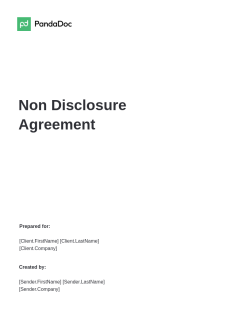Types of NDA
NDA documents differ in terms of their type, the number of parties affected, and the jurisdiction of intended use including:
- Unilateral / One-way. This document frees the disclosing party from any limitations on the use of confidential information while restricting the receiving party from its disclosing completely. The party intended to get the information often is not expected to share anything in return. The most common use cases are employment or seeking investments.
- Bilateral / Mutual. This type of agreement suggests both parties may share confidential information with each other and imposes equal limitations on its disclosure. Mutual NDAs are often used in product development, business cooperation, or research works.
- Multilateral. This type of agreement involves numerous parties and multiple types of private information. Unlike the two-above generic non-disclosure agreements, a multilateral NDA is often prepared for specific circumstances and with particular jurisdictions. An example is multiple companies cooperating on a single project or people working with different clients.
- Standalone. The document is represented as an independent confidentiality contract.
- Incorporated. The NDA form supplements a more extensive pack of documents or agreements, e.g., employment agreements, partnerships, or licensing contracts.
You also need to consider the geo factors (country, state) for your NDA to have legal enforceability. Some key ways that NDAs can differ by the state include:
- Statute of limitations: NDA validity period may differ state by state. The most common terms of duration for an agreement range between 1-10 years.
- State laws: Some states may have specific laws regarding defamation, unconscionability, and enforceability terms.
- Confidentiality Marking: Some states may demand the information specified in an NDA to be distinctly written as ‘confidential’ or ‘proprietary’.
The best way to ensure that your NDA is legally binding and enforceable in a specific state is to use a respective non disclosure agreement template which you can find at PandaDoc.
When to Use an NDA Template
A non disclosure agreement (NDA) template comes in handy whenever you have to deal with sensitive information. These can be trade secrets, proprietary information, technical data, financial information, personal information, etc. You may need to share this information with someone or vice versa, encourage someone to share it with you.
NDA use cases
- Business: When you enter into negotiations with a client, prospect, or partner, a mutual NDA template will help you keep your financial, product, or company information safe.
- Human Resource Management. When a potential employee will have access to sensitive company information, a non-disclosure form can be used to protect that information during and after the hiring process.
- Groundwork: If you are into science or perform any research work, you can use an NDA Agreement Template to ensure other researchers or investors won’t exploit your findings or share it without your consent.
- Software Development: Signing a Software Development Non-Disclosure Agreement has become commonplace. With this, companies can comfortably discuss cooperation terms with potential service providers or supply free software trials to their clients.
- Patents/Copyright. Having your employees and partners sign an international NDA example form is among the must-haves when it comes to protecting your patent work, copyright, and intellectual property (IP) rights.
How to Make an NDA Legally Binding
Creating an NDA from scratch can be daunting unless you get guidance from a professional attorney. Therefore, most people choose a template and customize it to their business case.
Whether you use one of the PandaDoc ready-made, free NDA forms or write one on your own, you need to follow these steps to cover all the necessary aspects and create a legally binding document.
- Write the parties involved. Clearly define the disclosing and receiving parties. Each party has its name, address, and contact information.
- Define confidential information. Specifically describe what information is considered confidential, and how it should be protected. Browse a standard NDA sample on PandaDoc to see how to get started formulating this section, or pick a free NDA example form and fill it on the go. When done, you’ll get a standard non disclosure agreement in PDF or ready to be shared online.
- State restrictions. Outline the specific restrictions on the use and dissemination of confidential information, including any limitations on the receiving party’s ability to use or disclose the information.
- Write exclusions. Specify any exclusions from confidentiality, such as information that is already publicly available or that the receiving party can demonstrate was independently developed.
- Define duration. Include the length of time the receiving party is bound by the agreement and the circumstances under which the NDA will terminate.
- Write remedies for breach. Include provisions for remedies for breach of the NDA, including any legal or financial penalties that may be imposed in the event of a violation.
- State governing law and jurisdiction. Specify which state or country’s laws will regulate potential disputes in court if any.
- Add signatures. Include signature lines for the parties involved, indicating their agreement to the terms.
Check the PandaDoc collection of free NDA agreement templates and pick the one that fits your case. Complete it online and get a professionally written printable non-disclosure agreement which you can download in PDF or share online.
5 Reasons to Use NDA Agreement Template
Even a simple NDA template signed properly and on time can save you much trouble down the road helping you protect yourself from unauthorized use of your information. But in practice, it’s more than that. Among the reasons to use a confidentiality agreement template in your work:
- Protect confidential information. NDAs let you protect proprietary knowledge, business data, financial details, private, or any other information you want. By using a free NDA template, the parties can ensure that all sensitive information is protected and the terms of its usage are clearly defined.
- Save time and money. Drafting a document from scratch can take up a great deal of time and can’t be done without attorney service, which can be costly. A premade template is a good foundation for your custom agreement which you can easily adjust to your use case. The PandaDoc service abounds with free NDA forms. All you need to do is just pick one that fits your needs.
- Ensure legitimacy. A professionally-written NDA template prevents you from disputes in court in case any of the parties violates the terms of the confidentiality contract.
- Establish trust. Both parties can freely exchange information which eventually encourages negotiations and speeds up cooperation making the process comfortable and transparent.
- Streamline document workflow. NDAs help to standardize and regulate the company document workflow between employees, partners, or clients.
It’s important to note that, it’s always recommended to seek legal advice from an attorney to make sure that the NDA template is suitable for the specific situation and jurisdiction.


















